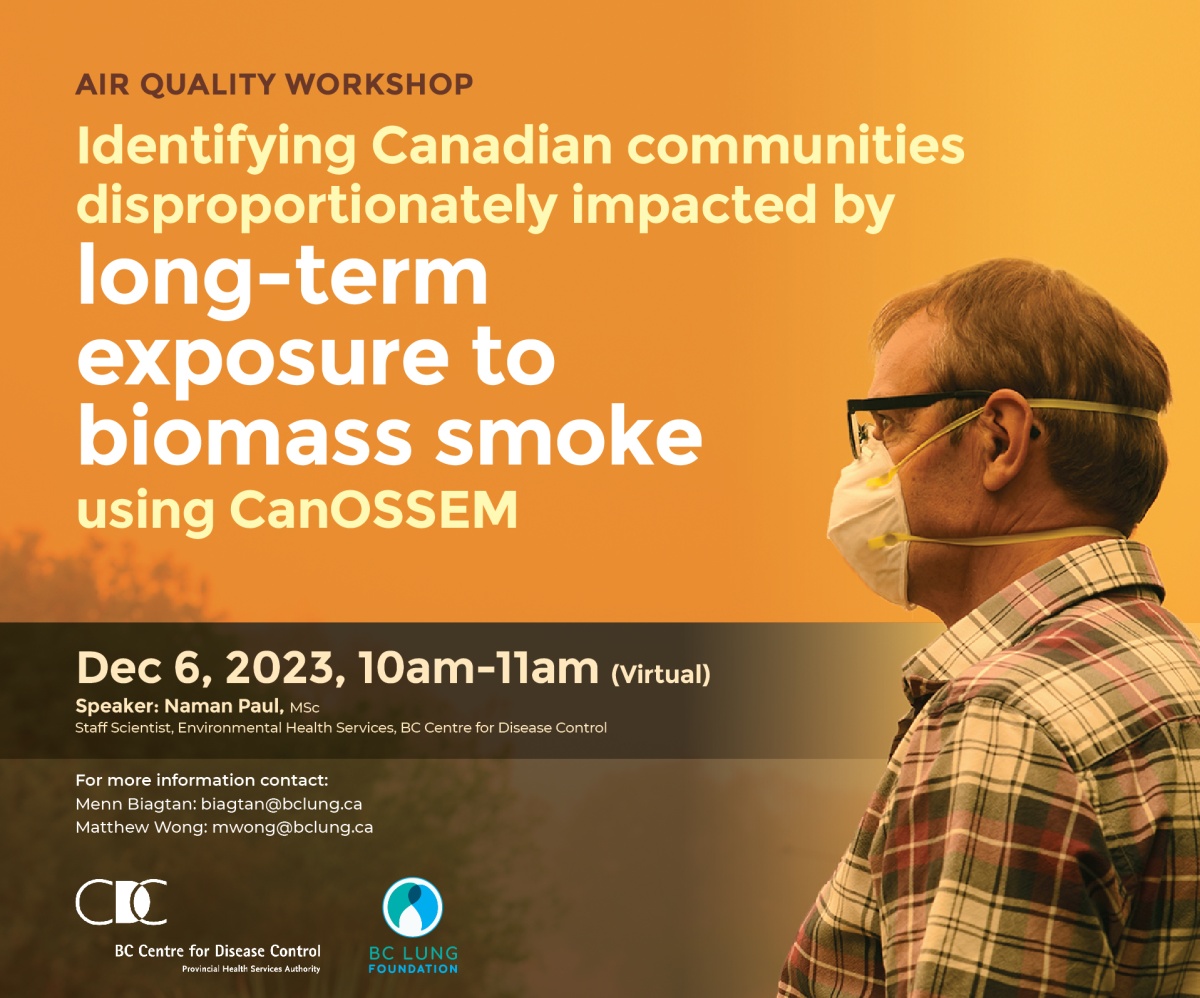AQ Webinar

The Canadian Optimized Statistical Smoke Exposure Model (CanOSSEM) uses machine learning to estimate daily PM2.5 exposure across Canada from 2010 to 2022. CanOSSEM generated PM2.5 estimates were used to identify communities disproportionately exposed to biomass smoke from wildfires and residential wood combustion.
We analyzed the number of biomass smoke exposure days (days that exceeded Canadian Ambient Air Quality Objective CAAQS) both during the typical wildfire months as well as the residential wood smoke season. This research lays the groundwork for pilot testing wildfire season AQHI-type forecasts for remote communities located hundreds of kilometers away from the nearest PM2.5 monitoring station and have been disproportionately exposed to elevated levels of biomass smoke in the past.
Join us on December 6th to hear more about the CanOSSEM from Naman Paul, a staff scientist working in Environmental Health Services at BC Centre for Disease Control. You won't want to miss out on this illuminating talk. Register for free below.
Questions? Contact Dr. Menn Biagtan, VP: biagtan@bclung.ca or Matthew Wong, Coordinator: mwong@bclung.ca, Health Initiatives & Programs.
June 2020: COVID-19 and Wildfire Smoke: A Potentially Bad Combination
- Dr. Sarah Henderson, Engineer and Epidemiologist, Sr. Environmental Scientist, BCCDC
- Dr. Chris Carlsten, Canada Research Chair (Occupational & Environmental Lung Disease), Head, UBC Respiratory Medicine
Exposure to air pollution can irritate the lungs, cause inflammation, and alter immune function, making it more difficult to fight respiratory infections such as COVID-19. Wildfire smoke is a complex mixture of different air pollutants that causes episodes of extremely poor air quality. When conditions are smoky, more people who are exposed to the novel coronavirus may develop COVID-19 and some cases of COVID-19 may become more severe.
November 2018: The Air Quality Health Index and Biomass Smoke in BC
- Dr. Sarah Henderson, Engineer and Epidemiologist, Sr. Environmental Scientist, BCCDC
Biomass smoke is an important source of air pollution associated with a range of cardiopulmonary health conditions in BC and elsewhere. The Air Quality Health Index (AQHI) is the most widely used tool in Canada to communicate with the public about air pollution. However, its 3-pollutant formulation may not adequately reflect health risks from fine particulate matter (PM2.5) sources such as wildfire, open burning, and residential wood heating. Two studies have been conducted to evaluate the ability of the AQHI and four alternate AQHI-Plus amendments to predict adverse population health effects associated with biomass smoke. Results suggest that a PM2.5-only AQHI-Plus may be better than the 3-pollutant AQHI for communicating about potential respiratory health effects during periods affected by biomass smoke, especially for those with chronic respiratory conditions such as asthma.
- Leila Steiner, MA, PhD candidate, Environmental Health & Knowledge Translation Scientist, BCCDC
Personal cultivation as described by the proposed Cannabis Act (2017) will permit adults to cultivate up to four cannabis plants per household. This provision is intended to both promote equity by facilitating access to legal cannabis, particularly when retail outlets are difficult to access, and to undercut the black market. However, indoor cultivation and processing of cannabis may also introduce or exacerbate certain environmental health risks in the home. At the National Collaborating Centre for Environmental Health, Leila is the lead on the cannabis and environmentla health file and has focused on risk communication and personal cultivation. She is also currently a Bridge Fellow at UBC. Her recent research has included work on endocrine disrupting compounds, food contact materials, and the science-policy interface.
June 2017: Air pollution and childhood asthma
- Dr. Eric Lavigne, SrE. pidemiologist, Air Health Science Division, Health Canada | Adjunct Professor, School of Epidemiology, Public Health and Preventive Medicine, University of Ottawa
Prenatal exposure to ambient air pollution has been associated with development of childhood asthma; however, less is known regarding the potential modifying factors in this association. This presentation will go through the literature on this issue and will present findings from a retrospective cohort study conducted in Ontario, Canada. This study examined effect modification by maternal asthma, as well as infant sex, birth outcomes and maternal place of residence in the association between prenatal exposure to ambient air pollution and development of childhood asthma.
January 2017: Radon: What you should know
- Winnie Cheng, Regional Radiation Specialist, Health Canada
Radon is a naturally-occurring radioactive gas formed from the decay of uranium in soil and rocks. Long-term exposure to radon is the second leading cause of lung cancer after smoking, and the leading cause of lung cancer for non-smokers. An estimated 220 radon-induced lung cancer deaths occur every year in B.C. Learning Objectives: What is radon, what are the health effects of radon? and how can we test and mitigate for radon?
November 2016: Air Pollution: What you should know
- Dr, Paula Smith, Air Quality Health Specialist Health Canada, Government of Canada
Air Pollution is often thought of as an ecological crisis and the health effects associated with exposure to air quality can easily be overlooked. However, according to the International Energy Agency’s 2016 World Energy Outlook report, “6.5 million deaths are attributed each year to poor air quality, making this the world’s fourth-largest threat to human health, behind high blood pressure, dietary risks and smoking. Learning Objectives: What constitutes air pollution, how air pollution causes millions of early deaths each year and what resources are available to help patients better manage the health risks associated with exposure to air pollution?

